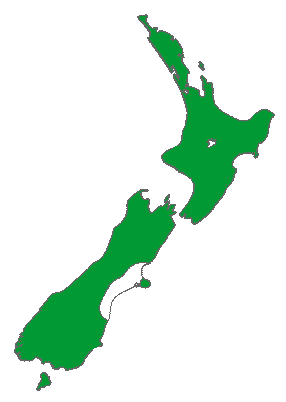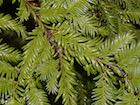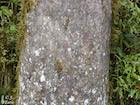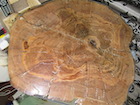Conservation Status

Pectinopitys ferruginea
(G. Benn. ex D. Don) C.N.Page 2019
Common names
Miro (Maori), Brown pine.
Taxonomic notes
Type: "Habitat in Nova Zelandia. Philipp, Bennett" (LINN? Not designated)" (Farjon 2010). Synonymy: See POWO for a full list. The only synonym you are likely to see in current use is Prumnopitys ferruginea (G.Benn.) de Laub. 1978.
The molecular analysis by Sinclair et al. (2002) considered a subset of taxa from throughout the Podocarpaceae that included 6 species in Prumnopitys sensu latu, representing the genera Pectinopitys, Prumnopitys and Sundacarpus. The 3 species of Pectinopitys, including P. ferruginea, were in a group sister to a clade containing Prumnopitys and Sundacarpus; Little et al. (2013) obtained a very similar result in a later molecular study. This, along with many points of morphology, constitute Page's (2019) basis for assigning this species to Pectinopitys rather than Prumnopitys.
Description
Tree to 25 m tall and 100 cm dbh with a round crown. Bark finely punctate, scaly, gray-brown, falling in thick flakes. Juvenile leaves light green or brown-red, up to 30 mm long, narrow-linear, acute. Adult leaves 15-25×2-3 mm, dark green, often secund, apex acute, midvein distinct, margins recurved, arranged in a plane on either side of the branchlet with stomata on the lower surface only. Pollen cones solitary, sessile, erect, catkin-like, 0.5-1.5 cm long, arising in the axils of the leaves. Buds of female flowers also arise from leaf axils, taking more than 12 months to ripen; they are usually borne singly at the end of a short axillary branchlet which is covered in small scales. The mature seeds are fully enclosed in a red, fleshy covering ca. 5 mm long, they are broadly oblong to sub-spherical, drupaceous, purplish, with glaucous bloom, up to 20 mm. long. Wood hard, durable, straight-grained (Allan 1961, Salmon 1996).
The bark somewhat resembles that of Prumnopitys taxifolia, but the foliage is quite unique in comparison with all other New Zealand native conifers, so it is difficult to mistake this tree for anything else (pers. obs. Mar-2003).
This species is always mycorrhizal, forming a vesicular-arbuscular mycorrhizas (Hurst et al. 2002).
Distribution and Ecology
New Zealand: North, South and Stuart Island, in lowland forest to an altitude of 1,000 m (Salmon 1996). Based on data from 720 collection localities, its climate preferences include a mean annual temperature of 10°C, with an average minimum in the coldest month of 1°C, and a mean annual precipitation of 2400 mm (Biffin et al. 2011, Table S5). Zone 9 (cold hardiness limit between -6.6°C and -1.1°C) (Bannister and Neuner 2001).
Ecologically, it appears to be a late-successional forest interior species, regenerating within the forest and typically only achieving canopy dominance after several gap-release events (Lusk and Smith 1998).
The IUCN classifies this species as "Least Concern" for human impacts due to its relatively extensive range and because, although the species was formerly heavily exploited for timber, it has been protected for several decades, is widespread in protected areas, and the population trend is increasing (Farjon 2013).
Remarkable Specimens
A tree 135 cm dbh and 24.9 m tall was found by Phil Barker, Bill Morris and associates near Lake Brunner (photos and further details are at New Zealand Notable Trees, accessed 2020.12.09). This tree dwarfs any others I have seen recorded.
The oldest sample I know of is shown in the cross-section at right, recovered from a tree cleared during highway construction and prepared and counted by Claude Grayson in 2019 (email 2019.03.08). This sample contains 744 rings, which is a limiting age. The sample shows severe ring wedging (photo) and thus may be even older.
Smale and Smale (2003), studying forest dynamics and tree growth rates, report ages of up to 549 years for trees growing in native forest remnants at Waihaha in the central North Island. Ages in this study were determined by simple ring-counts of increment cores taken at breast height.
Ethnobotany
See Conifers of New Zealand for a review of the historic role of forests in native and European cultures of New Zealand.
The Maori people crushed the seeds to obtain an oil that was rubbed onto the skin as an inspect repellent and to help recover from fever. The resinous exudate of the stem was applied to wounds and ulcer. An infusion prepared from leaves and bark was drunk to treat gonorrhoea and a bark infusion was taken for stomach ache. Maori also ate the fruit sometimes, though it smells and tastes like turpentine. The kereru, a large native pigeon, is fond of eating the "fruits" (ripe seed cones) and becomes thirsty afterwards; the Maori would place water troughs near fruiting trees and set snares around them. Some exceptional trees were tribal landmarks, and to some were attributed magical powers (tapu) (Barton 2023).
According to Kirk (1889), "the timber of miro bears considerable resemblance to that of matai [Prumnopitys taxifolia], from which, however, it is easily distinguished in cross section by the dark colour of the central portion of the heartwood. It is straight and even in the grain, compact, hard, elastic, and of great strength, but is not durable in situations where water can gain access to joints, or when in contact with the ground.
Its timber exceeds all New Zealand pines in strength. ... The heartwood is dark, and irregularly shaped when seen in cross-section, so that, when cut on the quarter, much of the timber is s beautifully figured. In the seasoned state it is apt to split when nails are driven into it without boring, and in other respects it is less easily worked than kauri [Agathis australis] or rimu [Dacrydium cupressinum], which is probably the chief cause of its unpopularity. The proportion of sapwood is larger than in matai. Figured specimens are adapted to the purposes of the cabinetmaker, and may also be used for ornamental turned-work. It is also suitable for house-framing, except ground-plates, flooring-boards, and weather-boards, for all of which it has been sparingly used with the best results. For weather-boards it is probably superior to rimu so long as it is not allowed to come in contact with the ground. It seems of especial value for beams required to carry a great weight, if under cover, and for this purpose is superior to the beeches and to all other New Zealand pines."
Observations
Miro can be seen along tracks in virtually all native forests on the North Island. Some examples include the forests at Te Urewera, Whirinaki, Taranaki, Ohinetonga, Pureora, Waitakere, Coromandel, Waipoua, Omahuta and Puketi Forest Parks and National Parks. There are also approximately 2,000 geolocated observations shown on iNaturalist (accessed 2023.02.27).
Remarks
The epithet ferruginea means "rusty" and refers to the foliage of young plants.
Citations
Allan, H. H. 1961. Flora of New Zealand. Volume I, Indigenous Tracheophyta. Wellington: R.E. Owen Government Printer.
Barton, Ian. 2023. Tane's Tree Trust: Miro (Prumnopitys ferruginea). https://www.tanestrees.org.nz/species-profiles/miro/, accessed 2023.02.27.
Farjon, A. 2013. Prumnopitys ferruginea. The IUCN Red List of Threatened Species 2013: e.T42538A2985892. https://dx.doi.org/10.2305/IUCN.UK.2013-1.RLTS.T42538A2985892.en, accessed 2023.02.27.
Hurst, S. E., M. H. Turnbull and D. A. Norton. 2002. The effect of plant light environment on mycorrhizal colonisation in field-grown seedlings of podocarp-angiosperm forest tree species. New Zealand Journal of Botany 40:65-72.
Little, Damon P., Patrick Knopf, and Christian Schulz. 2013. DNA barcode identification of Podocarpaceae—The second largest conifer family. PLoS ONE 8(11):e81008. https://doi.org/10.1371/journal.pone.0081008.
Lusk, C. H., and B. Smith. 1998. Life history differences and tree species coexistence in an old-growth New Zealand rain forest. Ecology 79(3): 795-806.
Page, Christopher N. 2019. New and maintained genera in the taxonomic alliance of Prumnopitys s.l. (Podocarpaceae), and circumscription of a new genus: Pectinopitys. New Zealand Journal of Botany 57(3):137–53. https://doi.org/10.1080/0028825X.2019.1625933.
Sinclair, W. T., R. R. Mill, M. F. Gardner, P. Woltz, Tanguy Jaffré, J. Preston, M. L. Hollingsworth, A. Ponge, and M. Möller. 2002. Evolutionary relationships of the New Caledonian heterotrophic conifer, Parasitaxus usta (Podocarpaceae), inferred from chloroplast TrnL-F intron/spacer and nuclear RDNA ITS2 sequences. Plant Systematics and Evolution 233(1–2):79–104.
Smale, M. C. and P. N. Smale. 2003. Dynamics of upland conifer/broadleaved forest at Waihaha, central North Island, New Zealand. Journal of the Royal Society of New Zealand 33(2):509-528.
See also
The New Zealand Plant Conservation Network, accessed 2010.11.22.
Gymnosperms of New Zealand.








